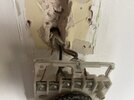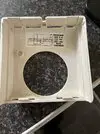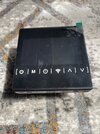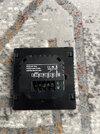Can anyone help me for wiring my old Honeywell thermostat to new MH-1823/L Smart switch
You are using an out of date browser. It may not display this or other websites correctly.
You should upgrade or use an alternative browser.
You should upgrade or use an alternative browser.
wiring? to replace old room stat with smart switch
- Thread starter Hawar2022
- Start date
Sponsored Links
have you got the instructions for your new switch? you old room stat appears to have a red and a black wire, in terminals 1 and 3
you can use a toothbrush or small paintbrush to clean the dirt off to make the colours clearer. the bare earthwire should be sheathed green and yellow.
no doubt you have a live and a switched live to start the central heating pump
it looks as if Switched Live would be in 3, if I understand the diagram correctly
the diagram on the old casing says that L should be in 1 and N should be in 2
the quality of the pic is very poor. there is also an unsheathed earth conductor in a terminal to the left of the pic. You need to work out what they are. Can you afford £8 for a multimeter?
Some old thermostats were wired without a Neutral. If it does not have a neutral wire, then your new switch will not work if it needs one, until you run a new cable.
you can use a toothbrush or small paintbrush to clean the dirt off to make the colours clearer. the bare earthwire should be sheathed green and yellow.
no doubt you have a live and a switched live to start the central heating pump
it looks as if Switched Live would be in 3, if I understand the diagram correctly
the diagram on the old casing says that L should be in 1 and N should be in 2
the quality of the pic is very poor. there is also an unsheathed earth conductor in a terminal to the left of the pic. You need to work out what they are. Can you afford £8 for a multimeter?
Some old thermostats were wired without a Neutral. If it does not have a neutral wire, then your new switch will not work if it needs one, until you run a new cable.
Last edited:
You will need a neutral for a smart switch, won’t you? Your old stat may just be a switched live.
you will have to run a new cable
Sponsored Links
Just seen this mate, why would this be?you will have to run a new cable
sorry my bad, just looked again and it is 3 core + earth, I thought it was twin and earthJust seen this mate, why would this be?
Thanks for your helpI would wire it the following way, taking these as Honeywell to new smart switch:
1 to L (input)
2 to N
Link a wire from L to L if it’s needed
3 to On
- Joined
- 27 Jan 2008
- Messages
- 23,668
- Reaction score
- 2,666
- Location
- Llanfair Caereinion, Nr Welshpool
- Country

I see your question is answered, but it does raise a question, why use a wall thermostat? And I don't really know why, other than tradition.
The rooms at least in my house have the temperature controlled by the lock shield valve and thermostatic radiator valve (TRV) on each radiator the latter used both time and temperature and is programmed to suit the room.
The return water temperature can be used to modulate or cause a mark/space ratio to control the water heaters output, I will call it a boiler, although I hope is never does boil the water.
It would be reasonably easy to monitor flow or temperature to work out when the TRV's have closed, but once the pump stops, then not so easy to work out when we want boiler to start again.
However my PC can read this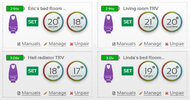 and it seems so easy, if the current is below target I want boiler and pump to run, so why do I need a wall thermostat? Although I have 14 TRV heads and only 4 are wifi, and 5 are bluetooth, if it just worked with the 4 that would be good enough.
and it seems so easy, if the current is below target I want boiler and pump to run, so why do I need a wall thermostat? Although I have 14 TRV heads and only 4 are wifi, and 5 are bluetooth, if it just worked with the 4 that would be good enough.
But my PC knows I need the boiler to run, but I see no way to translate that info to a simple switch to turn on the boiler, I would think that there is a if this than that (IFTTT) way to get the TRV heads to turn boiler on/off, this would also ensure the pump does not run when all TRV heads are closed, a speech request "Hey Google what is the living room temperature" gets a reply "TV side TRV set to 20°C and temperature at moment 19°C" so why can't a Google Nest switch also turn heating on/off, without any need for a wall thermostat?
I can see hall wall thermostat set to 17°C and at moment at 22°C, and hall TRV at 19°C and set to 20°C, which seems odd when both in the hall, but heat raises.
Maybe this is why Nest has come up with the temperature sensor rather than use the TRV, however since not released in the UK, does not help me.
The rooms at least in my house have the temperature controlled by the lock shield valve and thermostatic radiator valve (TRV) on each radiator the latter used both time and temperature and is programmed to suit the room.
The return water temperature can be used to modulate or cause a mark/space ratio to control the water heaters output, I will call it a boiler, although I hope is never does boil the water.
It would be reasonably easy to monitor flow or temperature to work out when the TRV's have closed, but once the pump stops, then not so easy to work out when we want boiler to start again.
However my PC can read this
 and it seems so easy, if the current is below target I want boiler and pump to run, so why do I need a wall thermostat? Although I have 14 TRV heads and only 4 are wifi, and 5 are bluetooth, if it just worked with the 4 that would be good enough.
and it seems so easy, if the current is below target I want boiler and pump to run, so why do I need a wall thermostat? Although I have 14 TRV heads and only 4 are wifi, and 5 are bluetooth, if it just worked with the 4 that would be good enough.But my PC knows I need the boiler to run, but I see no way to translate that info to a simple switch to turn on the boiler, I would think that there is a if this than that (IFTTT) way to get the TRV heads to turn boiler on/off, this would also ensure the pump does not run when all TRV heads are closed, a speech request "Hey Google what is the living room temperature" gets a reply "TV side TRV set to 20°C and temperature at moment 19°C" so why can't a Google Nest switch also turn heating on/off, without any need for a wall thermostat?
I can see hall wall thermostat set to 17°C and at moment at 22°C, and hall TRV at 19°C and set to 20°C, which seems odd when both in the hall, but heat raises.
Maybe this is why Nest has come up with the temperature sensor rather than use the TRV, however since not released in the UK, does not help me.
I see your question is answered, but it does raise a question, why use a wall thermostat?
to turn the heating on when the home is cold, and off when it is warm.
- Joined
- 27 Jan 2008
- Messages
- 23,668
- Reaction score
- 2,666
- Location
- Llanfair Caereinion, Nr Welshpool
- Country

But the TRV does that, so why a wall thermostat?to turn the heating on when the home is cold, and off when it is warm.
A TRV does not turn the heating on and off.
What is the point in firing up your boiler, and pumping hot water round the pipes on a hot day?
Just so the TRV can block it and send it round the bypass?
What is the point in firing up your boiler, and pumping hot water round the pipes on a hot day?
Just so the TRV can block it and send it round the bypass?
Last edited:
Thanks for your help.
I have done same as you said but not workingI would wire it the following way, taking these as Honeywell to new smart switch:
1 to L (input)
2 to N
Link a wire from L to L if it’s needed
3 to On
If your boiler has a timer it needs to be set to constantly on
DIYnot Local
Staff member
If you need to find a tradesperson to get your job done, please try our local search below, or if you are doing it yourself you can find suppliers local to you.
Select the supplier or trade you require, enter your location to begin your search.
Please select a service and enter a location to continue...
Are you a trade or supplier? You can create your listing free at DIYnot Local
Sponsored Links
Similar threads
- Replies
- 6
- Views
- 7K
- Replies
- 4
- Views
- 2K
- Replies
- 2
- Views
- 1K

